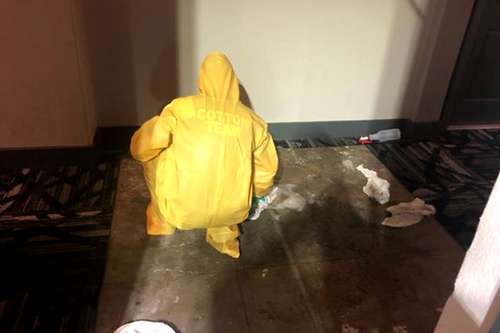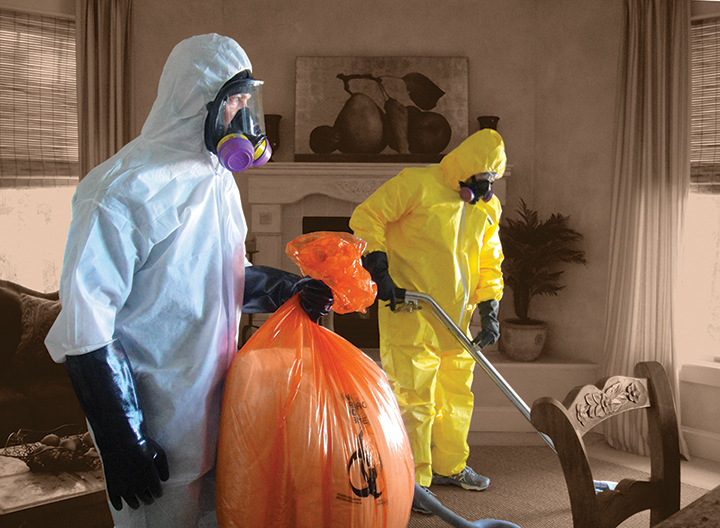Professional Biohazard Cleaning and Decontamination for Blood, Bodily Fluids, and Hazardous Products
The prospective wellness dangers associated with direct exposure to biohazards highlight the essential requirement for meticulous handling and comprehensive clean-up. As we navigate the detailed landscape of biohazard cleanup, understanding the subtleties of laws, compliance, and the specialized devices at play comes to be important in making sure a detailed and risk-free decontamination procedure.
Wellness Dangers of Biohazard Exposure
Exposure to biohazards poses significant wellness threats that can lead to serious effects for people and areas alike. Biohazards encompass a large variety of organic substances, consisting of blood, bodily fluids, mold, microorganisms, infections, and various other potentially transmittable products. When people come right into contact with these biohazards, whether through accidents, improper handling, or ecological direct exposure, they deal with the danger of having significant diseases or diseases.
One of the primary wellness threats linked with biohazard direct exposure is the transmission of transmittable diseases. Bloodborne virus such as HIV, hepatitis B and C, and different germs can be present in biohazardous products, posturing a direct threat to human wellness. Breathing in air-borne biohazards like mold and mildew spores or entering into call with infected surfaces can additionally cause breathing issues, allergies, and various other unfavorable wellness effects.
Moreover, biohazard exposure can have lasting wellness effects, with some conditions manifesting years after the first call (Blood Cleanup). For that reason, it is critical to prioritize correct biohazard cleaning and purification to alleviate these health risks and make certain the safety and security of communities and people

Specialized Training for Biohazard Cleaning
When it involves handling biohazard clean-up effectively and securely, specialized training plays an essential duty in ensuring proper purification procedures are adhered to. Biohazard cleanup calls for details knowledge and skills to efficiently reduce risks linked with bloodborne virus, physical liquids, and dangerous materials. Specialists learnt biohazard cleaning undertake rigorous direction on just how to securely handle, get rid of, and take care of biohazardous products to protect against contamination and exposure.
Specialized training for biohazard clean-up covers a series of essential topics, consisting of proper individual protective tools (PPE) use, bloodborne pathogen recognition, decontamination techniques, and contaminated materials disposal methods. People educated in biohazard cleaning are furnished with the necessary expertise to evaluate contamination degrees, recognize potential dangers, and apply proper cleaning treatments in compliance with governing requirements.
Continuous training and education are critical in the area of biohazard cleanup to stay upgraded on the most current decontamination modern technologies, security procedures, and guidelines. By spending in specialized training, biohazard cleaning specialists can efficiently react to emergency situation cleaning scenarios and safeguard both public health and wellness and the environment.
Value of Proper Decontamination Techniques
Using correct purification strategies is essential in biohazard clean-up to effectively decrease and eliminate dangerous materials health risks. Efficient purification not just guarantees the removal of noticeable traces of blood, bodily fluids, and various other biohazards however also targets undetectable pathogens that might present major health hazards if not properly eradicated. By adhering to rigid decontamination methods, educated professionals can substantially lower the risk of try this exposure to unsafe bacteria, viruses, and germs that might lead to illness or infections.
Appropriate purification methods entail using specific tools and anti-bacterials that are especially made to neutralize biohazards properly. Extensive cleansing and disinfection YOURURL.com of contaminated areas are essential to protect against the spread of pathogens and guarantee a risk-free environment for passengers. In addition, the right disposal of biohazardous waste complying with decontamination procedures is important in stopping contamination of other surfaces or individuals.

Devices and Devices for Safe Cleaning
When dealing with blood, bodily liquids, or hazardous products, biohazard cleaning experts depend on specialized gear to decrease direct exposure threats and completely sanitize the affected location. In addition, biohazard cleaning packages containing disinfectants, absorbent materials, and biohazard bags are used to securely have and get rid of of infected things.
Advanced cleaning tools like hospital-grade disinfectants, HEPA-filtered vacuum cleaners, and fogging machines are utilized to sanitize surface areas and get rid of biohazards efficiently. Specialized devices such as sharps containers and biohazard waste disposal bins are used to securely handle sharp things and biohazardous waste materials. By using the right devices and tools, biohazard cleaning professionals can ensure a complete cleanup process that prioritizes safety and lessens wellness dangers for both workers and occupants of the afflicted space.
Regulations and Conformity in Biohazard Cleaning
Appropriate adherence to regulations and conformity criteria is paramount in biohazard cleaning to make sure the safety of both workers and the setting. Government companies such as OSHA (Occupational Security and Health And Wellness Management) and the EPA (Environmental Protection Agency) have established particular guidelines for biohazard cleaning treatments to minimize health risks and ecological contamination. These regulations cover a variety of aspects consisting of the handling, transport, and disposal of biohazardous materials, in addition to the needed training and safety devices needed for workers entailed in the cleanup procedure.
Biohazard cleansing business should remain current with these policies to guarantee that their procedures fulfill the needed security criteria. Failing to comply with these policies can lead to serious consequences, including fines, lawsuit, and endangering the health of people and the environment. By following strict regulations and compliance measures, biohazard cleansing business can properly reduce threats and ensure a risk-free and complete clean-up process for all parties involved.
Conclusion
Finally, biohazard cleaning and purification require specific training, appropriate strategies, and adherence to guidelines. Direct exposure to blood, physical liquids, and dangerous products positions considerable wellness threats, making it essential to make use of the right devices and devices for secure cleaning. By complying with stringent methods and standards, experts can reference properly mitigate the dangers related to biohazard direct exposure and guarantee the safety of both themselves and others.
As we browse the detailed landscape of biohazard cleaning, recognizing the nuances of policies, compliance, and the specialized tools at play comes to be crucial in ensuring a thorough and secure purification procedure. (Blood Cleanup)
When it comes to dealing with biohazard cleaning efficiently and safely, specialized training plays an essential duty in guaranteeing appropriate purification procedures are adhered to.Using correct purification methods is essential in biohazard cleaning to properly lessen and eliminate hazardous products health and wellness risks. Furthermore, biohazard cleansing packages having disinfectants, absorbent materials, and biohazard bags are utilized to securely have and get rid of of infected products.
Government agencies such as OSHA (Occupational Security and Wellness Management) and the EPA (Environmental Security Company) have established certain standards for biohazard cleaning treatments to lessen wellness threats and environmental contamination.